Abstract
The present study investigated the rate of catabolism of CR1 (the C3b receptor, CD35) on erythrocytes (E) in vivo, in relationship with the expressed number of CR1/E, the CR1.1 HindIII quantitative CR1 polymorphism, and cell age. The relationship between the number of CR1/E and cell age was analysed by measuring G6PDH activity in E that had been sorted according to high or low expression of CR1 (CD35), by assessing the expression of CR1 (CD35) on E separated according to cell density, and by comparing the number of CR1 (CD35) antigenic sites on reticulocytes and on E. A physiological catabolism of CR1 (CD35) manifested by a reduction in the number of CR1 (CD35) antigenic sites/E with cell ageing was consistently observed in healthy individuals. The number of CR1/E decreased with ageing of E according to a complex pattern that associated an exponential decay and an offset. Calculated half-lives of CR1 (CD35) ranged between 11 and 32 days in healthy individuals. A more rapid loss of CR1 (CD35) with cell ageing occurred on cells from individuals expressing high numbers of CR1/E. In patients with systemic lupus erythematosus (SLE), half-lives of CR1 (CD35) on E were in the same range as those of healthy individuals with a similar quantitative CR1 genotype; the number of CR1 (CD35) on reticulocytes was reduced and linearly related to the number of CR1/E, independently of the patients' quantitative CR1 genotype. Transfusion experiments with E bearing high or low amounts of CR1/E indicated the lack of preferential removal of E bearing high numbers of CR1 (CD35) in patients with SLE. These results indicate that the rate of loss of CR1 (CD35) from E with cell ageing is directly related to the quantitative CR1 phenotype and suggest that enhanced peripheral catabolism is not the sole mechanism of the acquired loss of CR1 (CD35) on E in patients with SLE.
Full text
PDF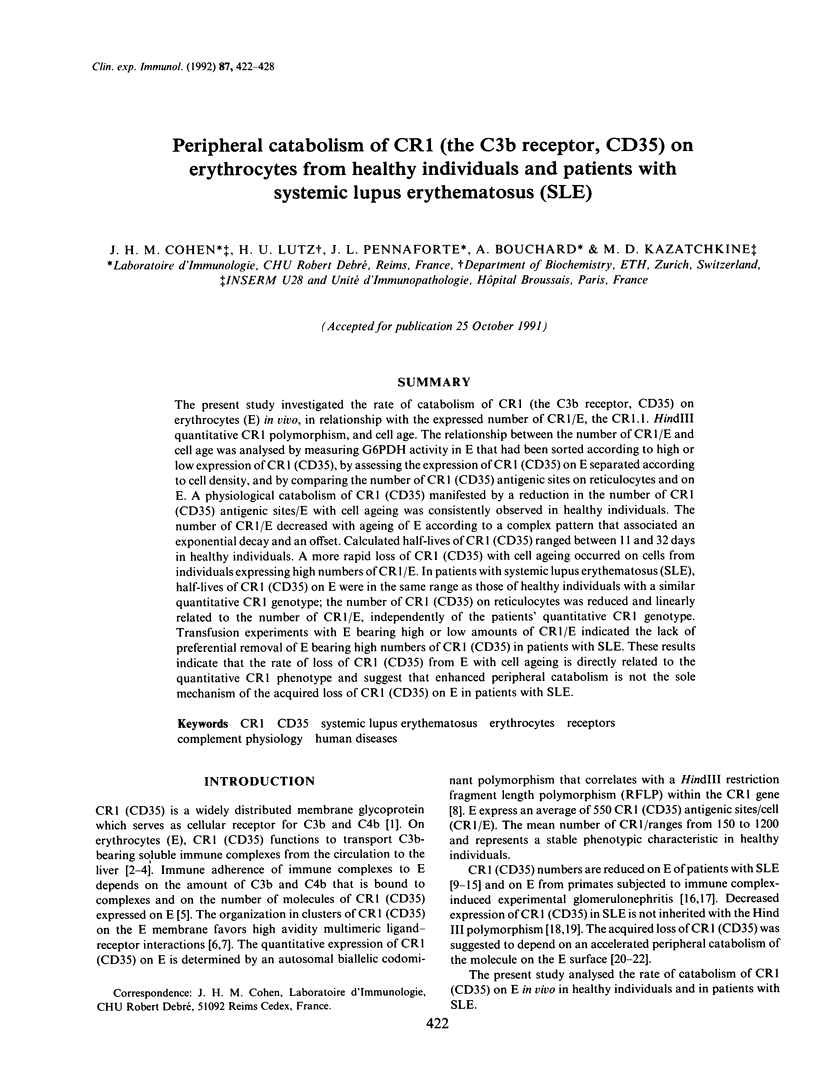
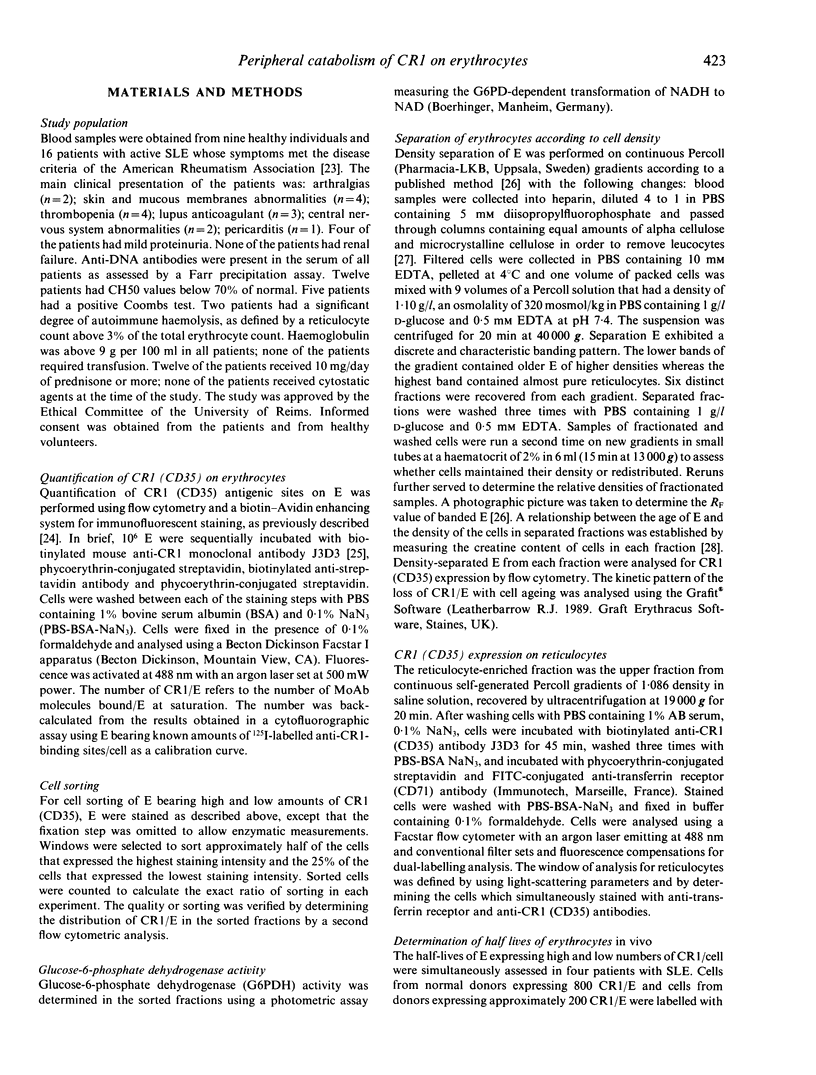
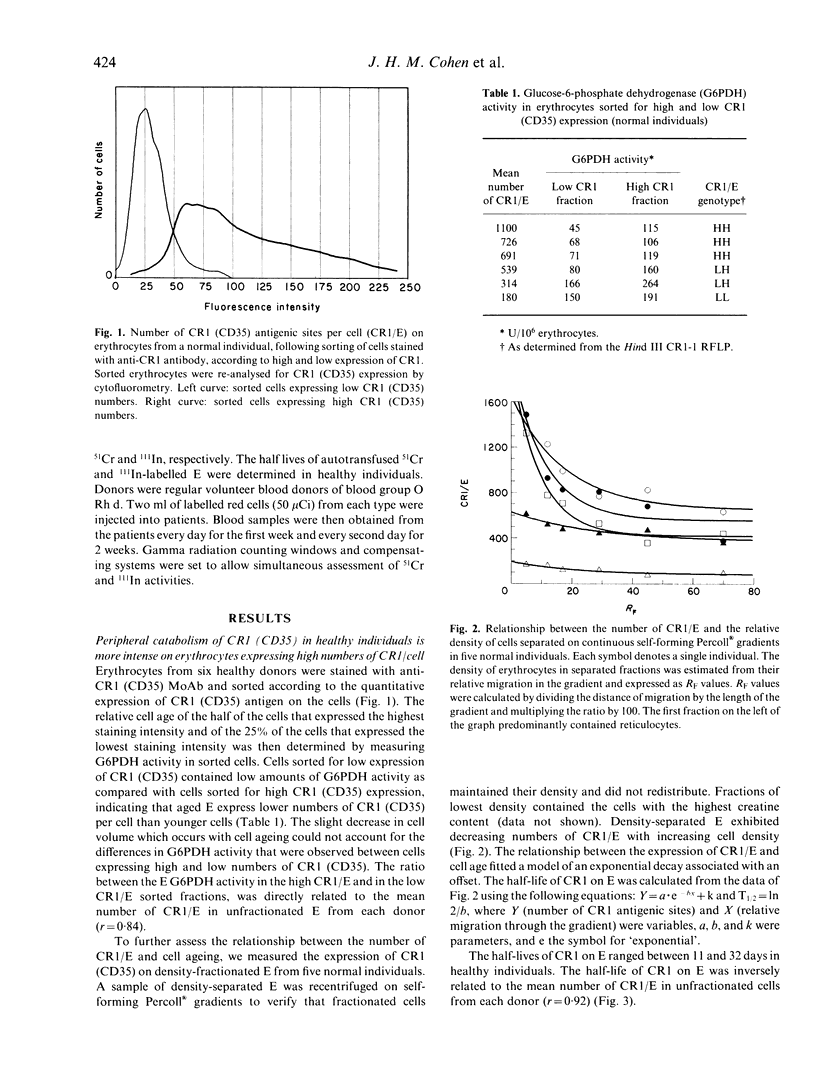
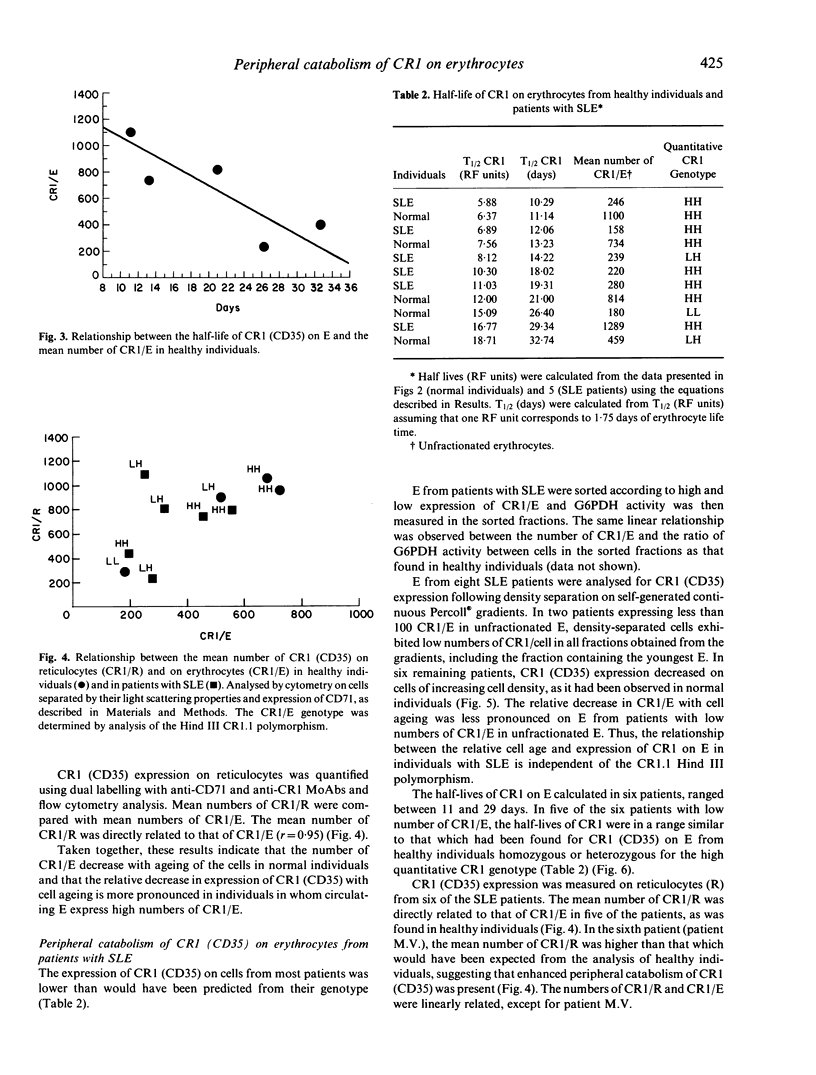
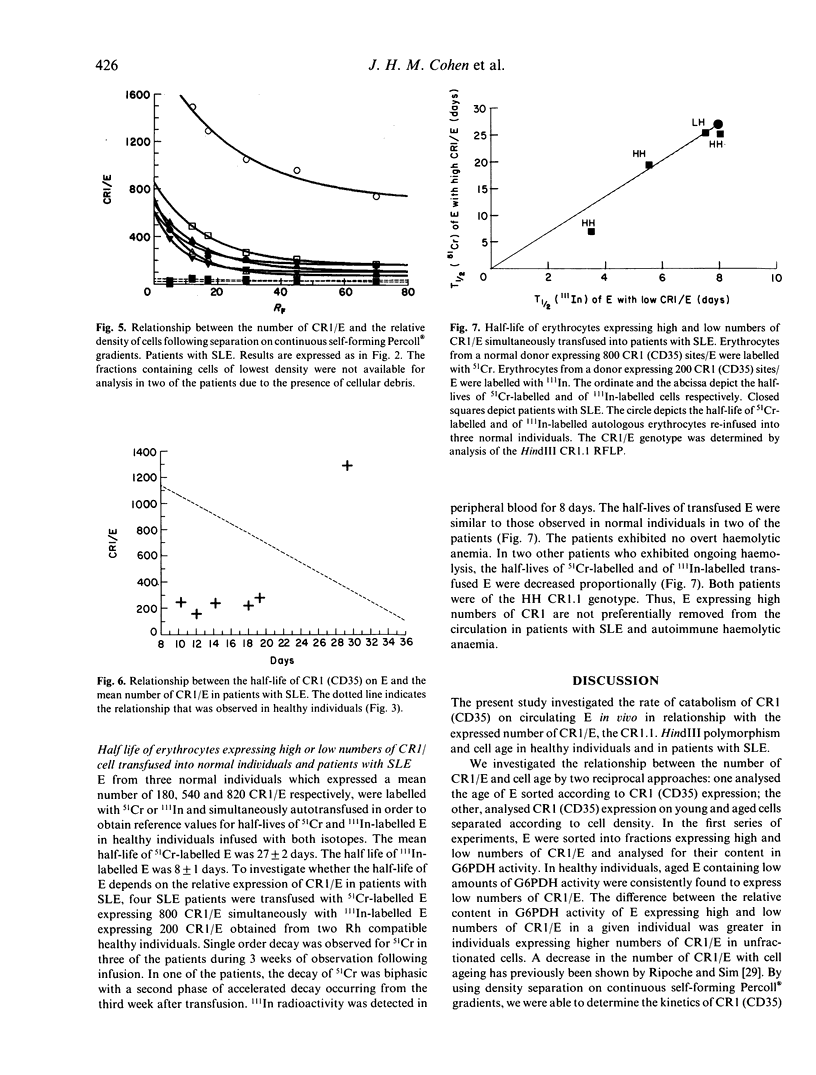
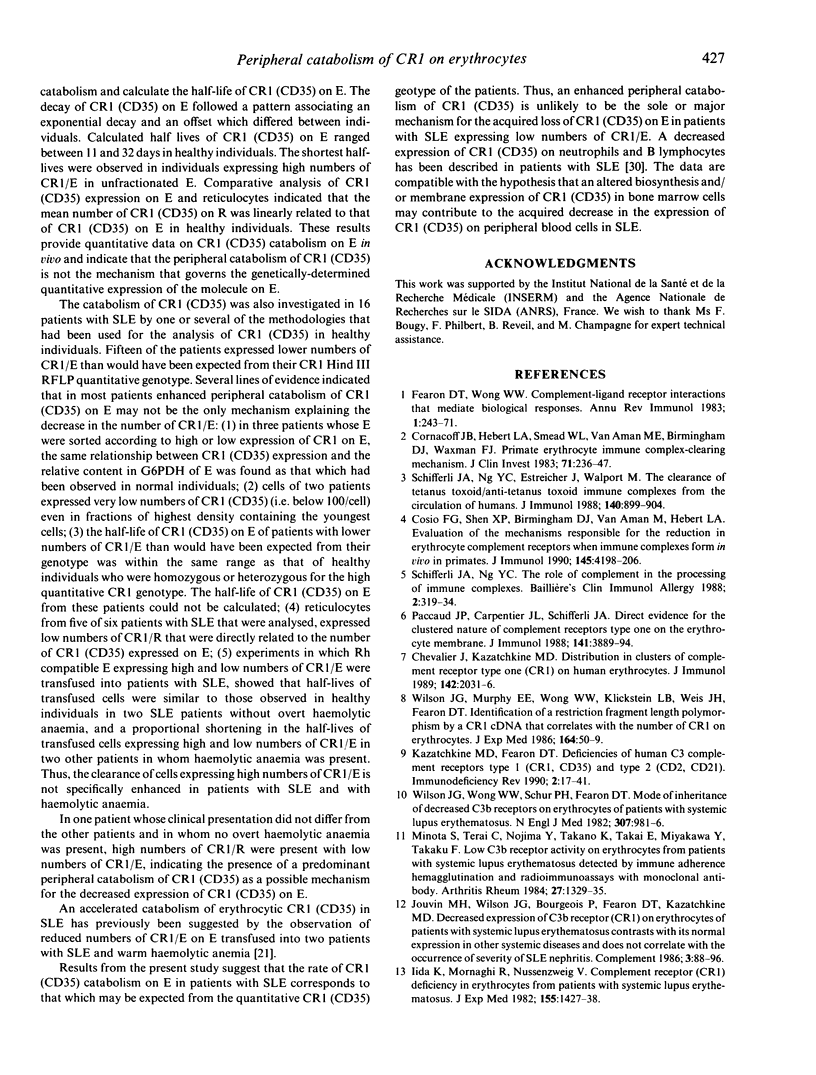
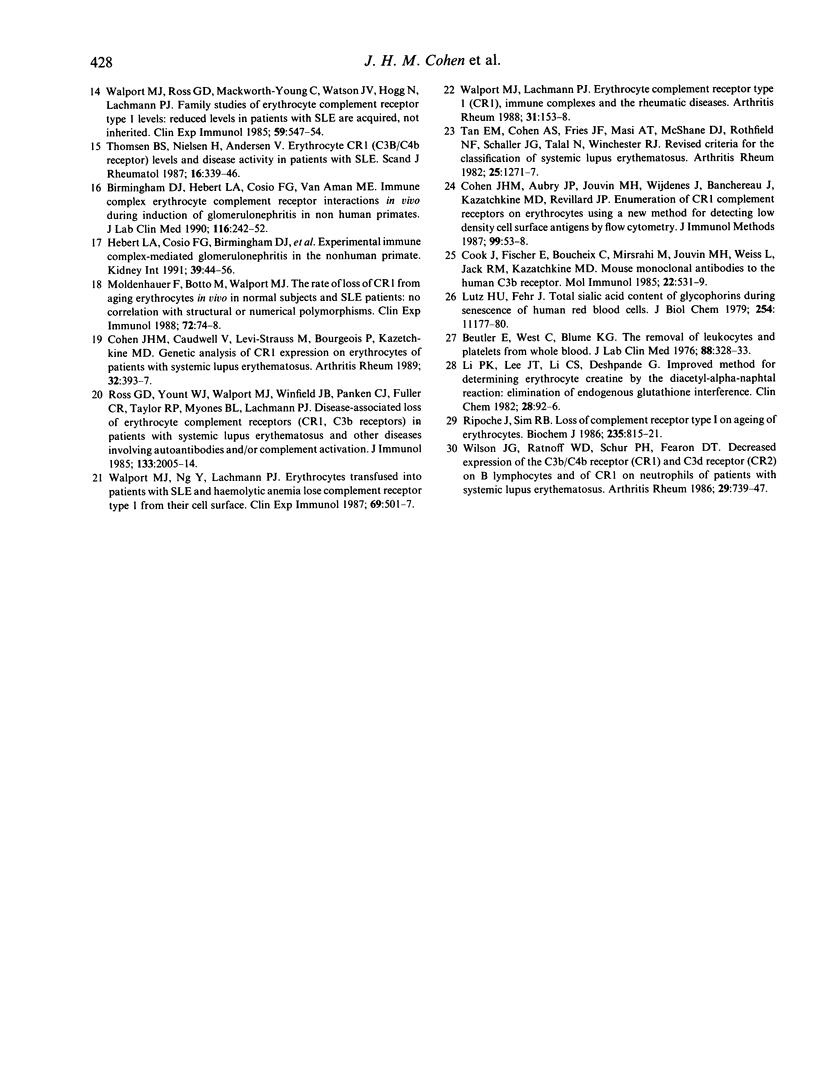
Selected References
These references are in PubMed. This may not be the complete list of references from this article.
- Beutler E., West C., Blume K. G. The removal of leukocytes and platelets from whole blood. J Lab Clin Med. 1976 Aug;88(2):328–333. [PubMed] [Google Scholar]
- Birmingham D. J., Hebert L. A., Cosio F. G., VanAman M. E. Immune complex erythrocyte complement receptor interactions in vivo during induction of glomerulonephritis in nonhuman primates. J Lab Clin Med. 1990 Aug;116(2):242–252. [PubMed] [Google Scholar]
- Chevalier J., Kazatchkine M. D. Distribution in clusters of complement receptor type one (CR1) on human erythrocytes. J Immunol. 1989 Mar 15;142(6):2031–2036. [PubMed] [Google Scholar]
- Cohen J. H., Aubry J. P., Jouvin M. H., Wijdenes J., Bancherau J., Kazatchkine M., Revillard J. P. Enumeration of CR1 complement receptors on erythrocytes using a new method for detecting low density cell surface antigens by flow cytometry. J Immunol Methods. 1987 May 4;99(1):53–58. doi: 10.1016/0022-1759(87)90031-7. [DOI] [PubMed] [Google Scholar]
- Cohen J. H., Caudwell V., Levi-Strauss M., Bourgeois P., Kazatchkine M. D. Genetic analysis of CR1 expression on erythrocytes of patients with systemic lupus erythematosus. Arthritis Rheum. 1989 Apr;32(4):393–397. doi: 10.1002/anr.1780320407. [DOI] [PubMed] [Google Scholar]
- Cook J., Fischer E., Boucheix C., Mirsrahi M., Jouvin M. H., Weiss L., Jack R. M., Kazatchkine M. D. Mouse monoclonal antibodies to the human C3b receptor. Mol Immunol. 1985 May;22(5):531–539. doi: 10.1016/0161-5890(85)90176-2. [DOI] [PubMed] [Google Scholar]
- Cornacoff J. B., Hebert L. A., Smead W. L., VanAman M. E., Birmingham D. J., Waxman F. J. Primate erythrocyte-immune complex-clearing mechanism. J Clin Invest. 1983 Feb;71(2):236–247. doi: 10.1172/JCI110764. [DOI] [PMC free article] [PubMed] [Google Scholar]
- Cosio F. G., Shen X. P., Birmingham D. J., Van Aman M., Hebert L. A. Evaluation of the mechanisms responsible for the reduction in erythrocyte complement receptors when immune complexes form in vivo in primates. J Immunol. 1990 Dec 15;145(12):4198–4206. [PubMed] [Google Scholar]
- Fearon D. T., Wong W. W. Complement ligand-receptor interactions that mediate biological responses. Annu Rev Immunol. 1983;1:243–271. doi: 10.1146/annurev.iy.01.040183.001331. [DOI] [PubMed] [Google Scholar]
- Hebert L. A., Cosio F. G., Birmingham D. J., Mahan J. D., Sharma H. M., Smead W. L., Goel R. Experimental immune complex-mediated glomerulonephritis in the nonhuman primate. Kidney Int. 1991 Jan;39(1):44–56. doi: 10.1038/ki.1991.6. [DOI] [PubMed] [Google Scholar]
- Iida K., Mornaghi R., Nussenzweig V. Complement receptor (CR1) deficiency in erythrocytes from patients with systemic lupus erythematosus. J Exp Med. 1982 May 1;155(5):1427–1438. doi: 10.1084/jem.155.5.1427. [DOI] [PMC free article] [PubMed] [Google Scholar]
- Jouvin M. H., Wilson J. G., Bourgeois P., Fearon D. T., Kazatchkine M. D. Decreased expression of C3b receptor (CR1) on erythrocytes of patients with systemic lupus erythematosus contrasts with its normal expression in other systemic diseases and does not correlate with the occurrence or severity of SLE nephritis. Complement. 1986;3(2):88–96. doi: 10.1159/000467884. [DOI] [PubMed] [Google Scholar]
- Kazatchkine M. D., Fearon D. T. Deficiencies of human C3 complement receptors type 1 (CR1, CD35) and type 2 (CR2, CD21). Immunodefic Rev. 1990;2(1):17–41. [PubMed] [Google Scholar]
- Li P. K., Lee J. T., Li C. S., Deshpande G. Improved method for determining erythrocyte creatine by the diacetyl-alpha-naphthol reaction: elimination of endogenous glutathione interference. Clin Chem. 1982 Jan;28(1):92–96. [PubMed] [Google Scholar]
- Lutz H. U., Fehr J. Total sialic acid content of glycophorins during senescence of human red blood cells. J Biol Chem. 1979 Nov 25;254(22):11177–11180. [PubMed] [Google Scholar]
- Minota S., Terai C., Nojima Y., Takano K., Takai E., Miyakawa Y., Takaku F. Low C3b receptor reactivity on erythrocytes from patients with systemic lupus erythematosus detected by immune adherence hemagglutination and radioimmunoassays with monoclonal antibody. Arthritis Rheum. 1984 Dec;27(12):1329–1335. doi: 10.1002/art.1780271202. [DOI] [PubMed] [Google Scholar]
- Moldenhauer F., Botto M., Walport M. J. The rate of loss of CR1 from ageing erythrocytes in vivo in normal subjects and SLE patients: no correlation with structural or numerical polymorphisms. Clin Exp Immunol. 1988 Apr;72(1):74–78. [PMC free article] [PubMed] [Google Scholar]
- Paccaud J. P., Carpentier J. L., Schifferli J. A. Direct evidence for the clustered nature of complement receptors type 1 on the erythrocyte membrane. J Immunol. 1988 Dec 1;141(11):3889–3894. [PubMed] [Google Scholar]
- Ripoche J., Sim R. B. Loss of complement receptor type 1 (CR1) on ageing of erythrocytes. Studies of proteolytic release of the receptor. Biochem J. 1986 May 1;235(3):815–821. doi: 10.1042/bj2350815. [DOI] [PMC free article] [PubMed] [Google Scholar]
- Ross G. D., Yount W. J., Walport M. J., Winfield J. B., Parker C. J., Fuller C. R., Taylor R. P., Myones B. L., Lachmann P. J. Disease-associated loss of erythrocyte complement receptors (CR1, C3b receptors) in patients with systemic lupus erythematosus and other diseases involving autoantibodies and/or complement activation. J Immunol. 1985 Sep;135(3):2005–2014. [PubMed] [Google Scholar]
- Schifferli J. A., Ng Y. C., Estreicher J., Walport M. J. The clearance of tetanus toxoid/anti-tetanus toxoid immune complexes from the circulation of humans. Complement- and erythrocyte complement receptor 1-dependent mechanisms. J Immunol. 1988 Feb 1;140(3):899–904. [PubMed] [Google Scholar]
- Tan E. M., Cohen A. S., Fries J. F., Masi A. T., McShane D. J., Rothfield N. F., Schaller J. G., Talal N., Winchester R. J. The 1982 revised criteria for the classification of systemic lupus erythematosus. Arthritis Rheum. 1982 Nov;25(11):1271–1277. doi: 10.1002/art.1780251101. [DOI] [PubMed] [Google Scholar]
- Thomsen B. S., Nielsen H., Andersen V. Erythrocyte CR1 (C3b/C4b receptor) levels and disease activity in patients with SLE. Scand J Rheumatol. 1987;16(5):339–346. doi: 10.3109/03009748709102505. [DOI] [PubMed] [Google Scholar]
- Walport M. J., Lachmann P. J. Erythrocyte complement receptor type 1, immune complexes, and the rheumatic diseases. Arthritis Rheum. 1988 Feb;31(2):153–158. doi: 10.1002/art.1780310201. [DOI] [PubMed] [Google Scholar]
- Walport M. J., Ross G. D., Mackworth-Young C., Watson J. V., Hogg N., Lachmann P. J. Family studies of erythrocyte complement receptor type 1 levels: reduced levels in patients with SLE are acquired, not inherited. Clin Exp Immunol. 1985 Mar;59(3):547–554. [PMC free article] [PubMed] [Google Scholar]
- Walport M., Ng Y. C., Lachmann P. J. Erythrocytes transfused into patients with SLE and haemolytic anaemia lose complement receptor type 1 from their cell surface. Clin Exp Immunol. 1987 Sep;69(3):501–507. [PMC free article] [PubMed] [Google Scholar]
- Wilson J. G., Murphy E. E., Wong W. W., Klickstein L. B., Weis J. H., Fearon D. T. Identification of a restriction fragment length polymorphism by a CR1 cDNA that correlates with the number of CR1 on erythrocytes. J Exp Med. 1986 Jul 1;164(1):50–59. doi: 10.1084/jem.164.1.50. [DOI] [PMC free article] [PubMed] [Google Scholar]
- Wilson J. G., Ratnoff W. D., Schur P. H., Fearon D. T. Decreased expression of the C3b/C4b receptor (CR1) and the C3d receptor (CR2) on B lymphocytes and of CR1 on neutrophils of patients with systemic lupus erythematosus. Arthritis Rheum. 1986 Jun;29(6):739–747. doi: 10.1002/art.1780290606. [DOI] [PubMed] [Google Scholar]
- Wilson J. G., Wong W. W., Schur P. H., Fearon D. T. Mode of inheritance of decreased C3b receptors on erythrocytes of patients with systemic lupus erythematosus. N Engl J Med. 1982 Oct 14;307(16):981–986. doi: 10.1056/NEJM198210143071604. [DOI] [PubMed] [Google Scholar]


